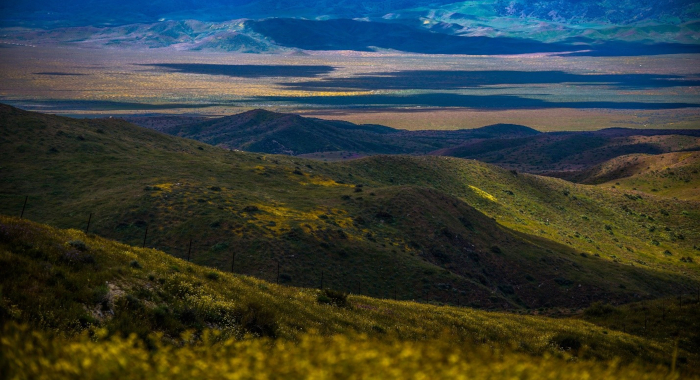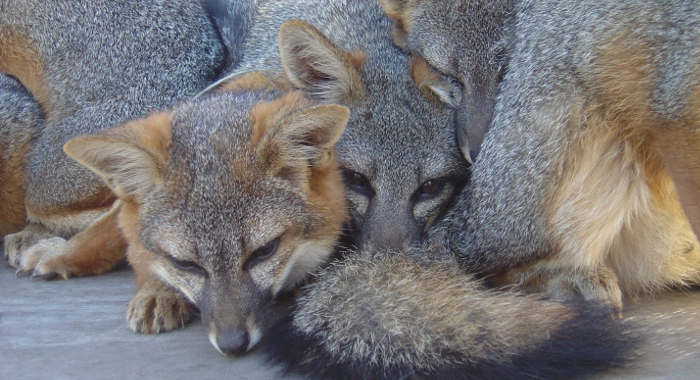Nearly half of California is protected in some land status that prevents most kinds of intensive human land uses. These lands support extensive natural habitats, and for many species, are a critical stronghold in an increasingly human-dominated world.
Yet, changes in the landscape in and near these places have left many in a degraded and precarious condition. Catastrophic wildfire, invasive species, and climate change threaten vast swathes of the state. Protected lands are becoming increasingly isolated by urban and agricultural development, roads, and other infrastructure. Such obstacles can limit a species’ ability to move to across the landscape and adapt to climate change.
Conservancy scientists are working to enhance the resiliency of protected lands in the face of rapid change, and to maintain the landscape connections necessary for plants and animals to adapt over time.


CL Boser, C Cory, KR Faulkner, JM Randall, JJ Knapp, SA Morrison
Biosecurity is the prevention of damaging non-native species’ arrival and establishment to new areas, for the protection of native plants and animals. This paper discusses the first iterations…J Yoon, TS Sillett, SA Morrison, CK Ghalambor
When members of a single species display very different behavioral patterns it can present a helpful model for ecological study. This paper examines two breeding populations of a songbird species: one…Luke Caldwell, Victoria J. Bakker, T. Scott Sillett, Michelle A. Desrosiers, Scott A. Morrison, Lisa M. Angeloni
The Island Scrub-Jay is the only island restricted bird species in the continental U.S. This study presents findings of a comprehensive breeding ecology study, aimed at elucidating demographic…HR Sofaer, TS Sillett, SI Peluc, SA Morrison, CK Ghalambor
Island archipelagos can provide useful opportunities for comparative studies in ecology. In this paper, for example, breeding ecology of a songbird was studied on two of the California Channel…TS Sillett, RB Chandler, JA Royle, M Kéry, SA Morrison
The Island Scrub-Jay occurs only on 250 km2 Santa Cruz Island. This study combined an intensive, short-term field survey with novel statistical modeling to generate estimates of population abundance,…JongminYoon, T. Scott Sillett, Scott A.Morrison, Cameron K. Ghalambora
When members of a single species display very different behavioral patterns it can present a helpful model for ecological study. This paper examines two breeding populations of a songbird species: one…Tim Bean, Bob Stafford, Laura Prugh, Scott Butterfield, Justin Brashares
This paper compares the efficacy of different monitoring methods for estimating distribution, abundance, and population growth of the endangered giant kangaroo rat to determine the best practices for…M. Rebecca Shaw, Kirk Klausmeyer, D. Richard Cameron, Jason MacKenzie, Patrick Roehrdanz
Species will move around the landscape as the climate changes, presenting challenges for traditional conservation strategies like land acquisition. This paper models the cost and total land area that…Scott A. Morrison, T. Scott Sillett, Cameron K. Ghalambor, John W. Fitzpatrick, David M. Graber, Victoria J. Bakker, Reed Bowman, Charles T. Collins, Paul W. Collins, Kathleen Semple Delaney, Daniel F. Doak, Walter D. Koenig, Lyndal Laughrin, Alan A. Lieberman, John M. Marzluff, Mark D. Reynolds, J. Michael Scott, Jerre Ann Stallcup, Winston Vickers, Walter M. Boyce
This paper discusses conservation of the Island Scrub-Jay in the context of novel threats posed by climate change. The authors discuss management actions that could reduce extinction…Walter M. Boyce, Winston Vickers, Scott A. Morrison, Scott Sillett, Luke Caldwell, Sarah S. Wheeler, Christopher M. Barker, Robert Cummings, William K. Reisen
As West Nile virus invaded the mainland southern California coast in 2003 there were widespread die-offs of certain species of bird. Corvids (e.g., jays, ravens, crows) were especially susceptible.…Sarah S. Wheeler, Stanley Langevin, Leslie Woods, Brian D. Carroll, Winston Vickers, Scott A. Morrison, Gwong-Jen J. Chang, William K. Reisen, Walter M. Boyce
Concerns about the spread of West Nile virus in North America and the high mortality it causes in corvids have led managers to consider vaccination as a strategy to proactively protect free-ranging…SA Morrison, KR Faulkner, LA Vermeer, L Lozier, MR Shaw
Eradication programs are complex undertakings that require comprehensive multidisciplinary planning and nimble adaptive implementation. This paper discusses the preparation that went into the most…A Saunders, JP Parkes, A Aguirre-Munoz, SA Morrison
Tremendous advances over recent decades in eradication of invasive species on islands raise the question whether there are now opportunities to further increase the pace and scale of that work. This…John M. Randall, Sophie S. Parker, James Moore, Brian Cohen, Laura Crane, Bill Christian, Dick Cameron, Jason B. Mackenzie, Kirk Klausmeyer, Scott Morrison
Regional conservation planning is critical to inform land and resource use decisions. The Mojave Desert Ecoregional Assessment represents an important advance in such planning, because of how its…CL Burdett, KR Crooks, DM Theobald, KR Wilson, EE Boydston, LM Lyren, RN Fisher, TW Vickers, SA Morrison, WM Boyce
Long-term studies of animal movement can generate data that allow for robust modeling of habitat use by the species. This study characterizes and maps the distribution of habitat for mountain lions in…John P. Parkes, David S.L.Ramsey, Norman Macdonald, Kelvin Walker, Sean McKnight, Brian S.Cohen, Scott A. Morrison
This paper describes the approach, planning, and field implementation of an intensive effort to eradicate a population of feral pigs from an island. Key elements of the project included comprehensive…Oberbauer, T., L. Luna Mendoza, N. Citlali Oliveres, L. Barbosa Deveze, I. Granillo Duarten, S.A. Morrison
Guadalupe Island in Mexico is undergoing a dramatic ecological recovery following the eradication of feral goats. Unfortunately, that eradication came too late for some species and ecosystems, and…